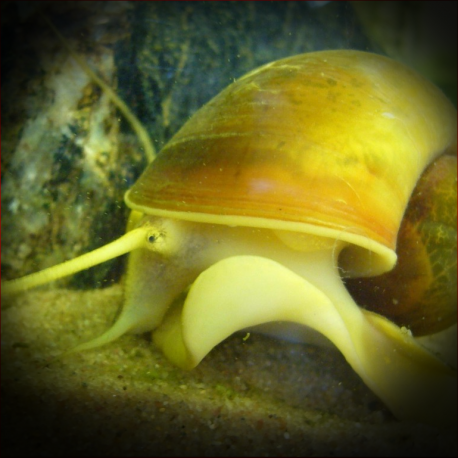More info
Datasheet
| Minimum Tank Size | 40 litres / 10.57 US gallons |
| Maximum Size | 45cm / 17.72inches |
| Temperament | Peaceful |
| Care Description | Easy |
| Temperature | 20.0°C / 68.00°F - 28.9°C / 84.02°F |
| Carbonate Hardness | 12-18 |
| pH | 7.8-8.4 |
General Description
The Gold Mystery Snail, belonging to the Pomacea genus within the Ampullariidae family, is characterized by its bright yellow shell and a distinctive siphon that extends to the water surface for breathing. Typically peaceful, these snails require open air space above the waterline in the aquarium for respiration and are best kept away from predatory tank mates.
Aquarium Setup
For Gold Mystery Snails, a tank size of at least 40 liters is recommended, with water conditions maintained at a pH of 7.8-8.4, a hardness of 12-18 dKH, and a temperature range of 20.0-28.9°C. Providing suitable vegetation and hiding spots in the aquarium is essential for their well-being (see table).
Behaviour
Gold Mystery Snails are nocturnal creatures that hide in vegetation during the day and become active at night. They occasionally leave the water to seek fresh vegetation. Being peaceful in temperament, they should not be housed with aggressive tank mates who may harm them.
Feeding and Diet
As omnivores, Gold Mystery Snails have a varied diet that includes algae, plants, vegetables, flake foods, frozen foods, and live foods. Both adults and young snails feed on the same diet, ensuring their nutritional needs are met for growth and development.
Reproduction & Dimorphism
Members of the Ampullariidae family, like the Gold Mystery Snail, exist as either male or female. Female snails are typically larger than males under similar environmental conditions. They lay eggs in clutches above the waterline, with hatchlings emerging within two to three weeks, feeding on similar foods as adult snails.
Habitat and Distribution
In their natural habitat, Gold Mystery Snails are found submerged in vegetation during the day and are distributed across various freshwater habitats. Their ability to adapt to different environments makes them an interesting species for aquarium enthusiasts to observe.

